402 - Hand Protection
- Appropriate hand protection shall be worn when there is a risk of the hands being burned, cut, mashed, or punctured, including inside the radiological control area (RCA). See glove matrix in this section for examples of glove types used for different tasks.
- Appropriate gloves shall always be worn
when the hands are being used in the work process. Examples include using hand
tools, such as wrenches, hammers, snips, and side cutters; offloading or
manipulating materials, including wood/metal products; working with glass/metal
shavings; pulling fire hoses, handling rigging slings; building scaffolding;
handling compressed gas cylinders; doing repetitive tasks that could cause
blisters; as well as ascending and descending ladders.
NOTE: Rubber gloves or two pair of surgeon’s gloves worn as part of anti-contamination clothing may be used for general work activities in contaminated areas, such as handling small instruments and climbing ladders. Work activities in contaminated areas that present additional hazards to the hands, such as exposures to cuts, lacerations, burns, etc., shall be evaluated to ensure proper gloves are selected in accordance with the glove matrix and worn in addition to the rubber gloves. - All employees shall have work gloves with them while working in an area requiring PPE, with the general exception of work in contaminated areas. Workers are not required to have work gloves with them when transiting through the RCA. In cases where work in contaminated areas poses a notable risk to the hands as identified in items 1 and 2, the worker shall wear substantial hand protection.
- Employees shall remain aware that when handling supplies, foreign objects that can cut or abrade the hands could be imbedded in the material.
- The use of cut-resistant gloves shall always be considered prior to beginning work with any type of handheld cutting tool. The cut resistant glove must be ANSI cut level 3 or higher.
- Cut-resistant gloves shall always be worn when cutting in the line of fire cannot be avoided.
- For special situations, such as using a chemical-resistant glove to handle a hazardous material, glove selection and inclusion shall be an integral part of pre-job planning and the pre-job brief. The same is true for electrical-insulated gloves.
- Where chemical-resistant gloves are worn with a chemical-resistant coat, special consideration must be given to wearing the gloves under the coat to reduce the potential of hazardous chemicals entering the glove cuff.
- There are a few situations when a glove can become hazardous, such as around rotating equipment. In this case, gloves can be removed. Gloves may also be removed when special dexterity is needed to do the job, such as operating switches or instruments.
Glove Matrix Examples
Work Gloves

LEATHER WORK GLOVES
1. Provide abrasion resistance (For example, using tools, such as wrenches and hammers; or handling materials such as wood and metal)
2. Provide protection against repetitive tasks that often cause blisters.
3. Can be used on electrical equipment in accordance with NMP-FLS-003.

MECHANICS GLOVES*
Provide abrasion resistance with high grip strength (For example, manipulating large equipment, such as piping and valves).

CUT RESISTANT GLOVES (MUST BE ANSI CUT LEVEL 3 OR HIGHER)*
Provide cut, puncture, and flame resistance (For example, using cutting tools, such as box cutters, side grinders, circular saws, and cutting torches).
* Not to be used on electrical equipment when voltage-rated gloves are required.
Chemical Gloves
NOTE: See the manufacturer of specific glove for usage requirements for the chemical in question.
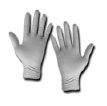
DISPOSABLE NITRITE RUBBER GLOVES
High tensile strength and dexterity; provide biological and chemical protection (not for prolonged exposure to chemicals)

POLYVINYL ALCOHOL-COATED GLOVES
Provide abrasion, puncture, and cut resistance; nearly inert to strong solvents and chemicals
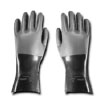
RUBBER TEXTURED GLOVES
Provide oil, acid, solvent, and caustic resistance
Voltage Rated Gloves
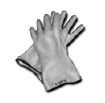
CLASS 00 RUBBER INSULATING GLOVES
Provide electrical shock protection up to 500 VAC or 750 VDC

CLASS 0 RUBBER INSULATING GLOVES
Provide electrical shock protection up to 1000 VAC or 1500 VDC
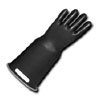
CLASS I RUBBER INSULATING GLOVES
Provide electrical shock protection up to 7500 VAC or 11200 VDC

CLASS II RUBBER INSULATING GLOVES
Provide electrical shock protection up to 17000 VAC or 25500 VDC
Voltage Rated Gloves
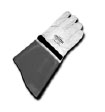
LEATHER PROTECTOR GLOVES WITH CUFF
Worn over insulating rubber gloves to provide mechanical protection against cuts, abrasions, punctures
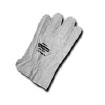
LEATHER PROTECTOR GLOVES WITHOUT CUFF
Worn over insulating rubber gloves to provide mechanical protection against cuts, abrasions, punctures
Specialty Gloves

NON-ASBESTOS HEAVY WEIGHT KEVLAR GLOVES
Worn over insulating rubber gloves. Provide cut, puncture, and flame resistance up to 850°F

WELDING GLOVES MADE OF PIGSKIN
Used ONLY for welding

100% NYLON FUEL HANDLING GLOVES
Provide protection against fuel
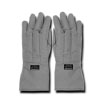
BLUE CRYOGENIC CHEMISTRY GLOVES
Provide protection in cryogenic atmospheres and during heat treatment of metals
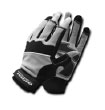
FRAMER GLOVES
Provide very limited abrasion protection. For use when performing low-risk activities requiring high dexterity only, such as very small parts. For all other activities, gloves providing adequate protection must be worn.
